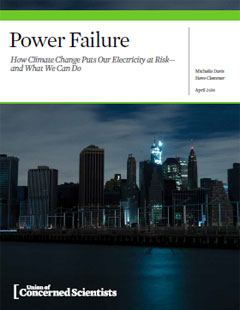Extreme weather events have become more frequent and costly in recent decades. In 2011 and 2012 alone, 25 extreme weather events caused $188 billion in damages and 1,100 fatalities. In 2012, eight million people across 21 states lost power as a result of Hurricane Sandy.
Such extreme weather events are likely to increase as global temperatures continue to rise, with significant consequences for the electricity sector.
To effectively address these growing climate risks — and ensure a reliable supply of electricity for years to come — we must take steps today to improve our aging electricity infrastructure and reduce the carbon emissions that are driving up the planet's temperature.
Ramping up renewable energy is a key component of this effort, both to make our electricity system more resilient and reliable in the short-term, and to curb climate change over the long-term.
The growing consequences of climate change increasingly threaten our electricity system
Accelerating sea level rise: Today some 100 electric facilities in the contiguous U.S., including power plants and substations, are sited within four feet of local high tide. Global average sea level has increased eight inches since 1880, and is projected to rise up to an additional 6.6 feet over the course of this century, greatly increasing coastal flooding risks.
Increasing wildfires: Wildfires can directly damage transmission poles and other electricity infrastructure, but the greatest risk comes from smoke and particulate matter, which can ionize the air, create an electrical pathway away from transmission lines, and shut down the lines. Climate change affects multiple factors that increase wildfire risk; the average number of large wildfires in the western U.S. rose from 140 in the 1980s to 250 between 2000 and 2012.
More frequent and intense heat waves: Climate change is already bringing more intense, more frequent, and longer lasting heat waves in North America. These periods of extreme heat decrease the efficiency of power plants during periods when electricity demand is highest, placing additional stresses on the electricity system.
Droughts and reduced water supplies: The electricity sector is highly dependent on water for cooling. Power production accounts for the single largest share of all freshwater withdrawals in the U.S. As temperatures continue to rise, droughts and reduced water supplies are likely to become the norm in some regions, increasing the risk to the power sector.
Elevated water temperatures: Higher air temperatures warm the water in rivers and reservoirs used by power plants for their cooling needs. If the temperature of incoming water is too hot, or if the temperature of the discharge water is too high, power plants must dial back production or shut down temporarily, as has occurred at numerous coal and nuclear power plants over the past decade.
Additional actions are necessary to better prepare our electricity system to withstand the effects of climate change
-
Smaller-scale, more distributed power: Renewable technologies like wind turbines and rooftop solar panels are small, distributed, and often weather storms and heat waves better than conventional power plants. If individual turbines or solar panels are damaged, the impact on the grid is far less than if a large coal or nuclear plant goes off-line.
-
Reduced water risks: Unlike conventional power plants, wind turbines and solar panels do not require water to produce electricity.
-
Decreased fuel supply risks: Most renewable technologies utilize on-site energy sources such as wind and sunshine, making them far less vulnerable to interruptions in fuel supplies. In contrast, fossil fuel supplies must be extracted, processed, and transported, a supply chain with many climate-related vulnerabilities.
-
Low-carbon electricity: Renewable energy generates little to no carbon emissions and helps reduce the amount of heat-trapping emissions generated by the electricity sector.
-
Adapt to the unavoidable consequences of climate change. Some impacts from climate change are now inevitable. To reduce the likelihood of power outages in the future, we must prepare for the risks we currently face. Measures like burying transmission lines or elevating or relocating equipment can help reduce the risk of outages, but these approaches are often expensive and may not be the most cost-effective long-term solution.
-
Reduce the problem by reducing demand. Energy-efficient homes and businesses require less electricity, deferring or eliminating the need to build new power plants and power lines. Less energy infrastructure means less equipment is vulnerable to damage from extreme weather events.
-
Conduct vulnerability assessments. Cities, counties, and states should conduct thorough assessments to evaluate the risks of climate change to their electricity infrastructure.
-
Incorporate climate adaptation and mitigation measures into utility resource planning. State and local governments should require utilities to consider the costs of adapting to and mitigating climate change in their long-term planning.
-
Upgrade electricity infrastructure. Power plant owners should install technologies that use less water. Utility and grid operators should pursue approaches that make the grid more flexible and better able to intergrate renewable energy sources. These include expanding transmission capacity and energy storage, adopting demand-response programs, and developing microgrids to better isolate outages.
-
Strengthen clean energy policies. State and federal policy makers should adopt and strengthen programs that support the timely expansion of renewable energy and energy efficiency, such as renewable electricity standards. The U.S. Environmental Protection Agency should finalize and implement strong standards to reduce heat-trapping emissions from new and existing power plants.
Rights and permissions: You are free to use the map graphics above without alterations online, in written materials, and in presentations. Any online use must include proper citation and a link to this web page.




